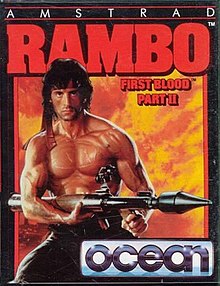Rambo (1985 video game)
| Rambo | |
|---|---|
 | |
| Publisher(s) | Ocean Software |
| Platform(s) | Amstrad CPC, Commodore 64, ZX Spectrum |
| Release | December 1985[1] |
Rambo (stylized on-screen as Rambo: First Blood Part II) is a 1985 video game based on the film Rambo: First Blood Part II (1985). The game was designed by David Collier and Tony Pomfret with the ZX Spectrum version converted by Platinum Productions.[1]
The Commodore 64 version's music is by Martin Galway from Northern Ireland, incorporating melodies from the film's score. The Amstrad CPC version's music was played and recorded live by Choice Software's in-house programmer/designer/musician James Edward Cosby also from Northern Ireland, using a Yamaha DX7 synthesiser via the then new MIDI serial comms protocol.
Several other games based on the film were also released, including Rambo for the Nintendo Entertainment System, and Rambo: First Blood Part II for the Master System.
Gameplay

The game follows the movie's story. The player, who is controlling Rambo, has to find his lost equipment, locate the POW camp, rescue the hostages, and make it back to the extraction point while being pursued by constantly respawning enemies. Rambo starts off with just a Bowie knife and grenades (both of which have an unlimited supply, as with all the weapons), and gains points for killing the enemy, and for collecting the following equipment: Rocket Launcher, M16 Rifle, and Bow & Arrows (Explosive & Non Explosive).
The gameplay is based on Capcom's arcade game Commando (1985).[2]
Reception and related releases
| Publication | Score |
|---|---|
| Crash | 79%[4] |
| Computer and Video Games | 33/40[3] |
| Sinclair User | |
| Your Sinclair | 8/10[6] |
| ACE | |
| Zzap!64 | 96%[8] |
| Publication | Award |
|---|---|
| Zzap!64 | Gold Medal |
Rambo was well received. Your Sinclair described it as "a thinking man's Commando. That game starts fast and gets faster until you end up like a one-man whirlwind. Rambo develops into a solid shoot'em up".
Rambo replaced Commando as the number one game in the Gallup ZX Spectrum chart[9] and did the same on the Commodore 64 and All Formats charts the following week.[10] The Amstrad CPC version also went to number one eight weeks later, replacing Yie Ar Kung Fu.[11]
The Amstrad CPC and ZX Spectrum versions of the game were included on the 1986 compilation They Sold a Million 3,[12][13] along with Fighter Pilot, Ghostbusters, and Kung-Fu Master.
In 1989, Ocean released the game alongside Daley Thompson's Decathlon and Enduro Racer as one of the launch titles for their new budget range, The Hit Squad.[14][15] It reached number 4 in the All Formats Budget Games chart.[16]
References
- ^ a b Peter Shaw (December 1985). "Rambo". Your Spectrum. No. 21. Sportscene Specialist Press. pp. 56–57.
- ^ "Going Platinum". Crash. No. 32. Newsfield. October 1985. pp. 124–126.
- ^ "Computer & Video Games".
- ^ "Crash".
- ^ "Sinclair User".
- ^ "Rambo". ysrnry.co.uk. Archived from the original on 2015-06-26. Retrieved 2015-09-05.
- ^ "ACE".
- ^ "Zzap!64 100th Issue Pull-Out Special Page 5". zzap64.co.uk. Retrieved 2015-09-05.
- ^ "Charts". Popular Computing Weekly. No. 2. Sunshine Publications. 9 January 1986. p. 35. Retrieved 9 March 2023.
- ^ "Charts". Popular Computing Weekly. No. 3. Sunshine Publications. 16 January 1986. p. 35. Retrieved 9 March 2023.
- ^ "Charts". Popular Computing Weekly. No. 11. Sunshine Publications. 13 March 1986. p. 35. Retrieved 9 March 2023.
- ^ "They Sold a Million 3". Spectrum Computing. Retrieved 2023-06-14.
- ^ "They Sold a Million 3 for Amstrad CPC (1986) - MobyGames". mobygames.com. Retrieved 2015-09-05.
- ^ "Ocean Hit Squad: Collect the set". New Computer Express. No. 26. Future Publishing. 6 May 1989. p. 2. Retrieved 9 March 2023.
- ^ "A Big Drop in the Ocean". Sinclair User. No. 88. EMAP. 18 June 1989. p. 22. Retrieved 9 March 2023.
- ^ "Top Ten Budget Games". New Computer Express. No. 37. Future Publishing. 22 July 1989. p. 5. Retrieved 9 March 2023.
